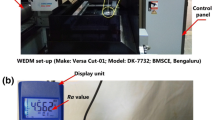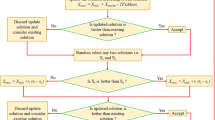Abstract
Wire electrical discharge turning (WEDT) is a non-conventional machining process, which was developed to machine cylindrical components on difficult-to-machine, but electrically conductive materials with high precision. In the present work, roundness, cylindricity and areal surface roughness of the parts created by WEDT process are investigated. Inconel 825 was the material chosen for the present study. The main objective of this study is to identify the optimum process parameters required to obtain improved geometry of the turned components with respect to roundness, cylindricity and areal surface roughness. The effects of machining parameters in WEDT process on the output responses are studied using experiments based on Box–Behnken design. ANOVA has been performed to study the effect of process parameters on the output responses. A novel optimization approach is used to identify the optimum parameters for each response. Teaching learning-based optimization (TLBO) is used to optimize the process, considering the three output responses in order to improve the quality of the turned products. Validation experiments were conducted, and the predicted results were verified. It is observed that the roundness, cylindricity and areal surface roughness of components machined with WEDT process obtained from TLBO technique and validation experiments are in close agreement. The surface morphology of the samples having maximum and minimum Sa value was studied using SEM micrographs. Finally, a microelectrode of 185 µm diameter and 4 mm length was successfully fabricated with multiple cut strategy using the WEDT setup in order to demonstrate the process capability.














Similar content being viewed by others
References
Jun Qu, Shih Albert J, Scattergood Ronald O (2002) Development of the cylindrical wire electrical discharge machining process, part 1: concept, design, and material removal rate. Trans ASME 124:702–707
Jun Qu, Shih Albert J, Scattergood Ronald O (2002) Development of the cylindrical wire electrical discharge machining process, part 2: surface integrity and roundness. Trans ASME 124:708–714
Janardhan V, Samuel GL (2010) Pulse train data analysis to investigate the effect of machining parameters on the performance of wire electro discharge turning (WEDT) process. Int J Mach Tools Manuf 50:775–788
Mohammadi Aminollah, Tehrani Alireza Fadaei, Emanian Ehsan, Karimi Davoud (2008) A new approach to surface roughness and roundness improvement in wire electrical discharge turning based on statistical analyses. Int J Adv Manuf Technol 39:64–73
Haddad Mohammad Jafar, Alihoseini Fereshteh, Hadi Mostafa, Hadad Meysam, Tehrani Alireza Fadaei, Mohammadi Aminollah (2010) An experimental investigation of cylindrical wire electrical discharge turning process. Int J Adv Manuf Technol 46:1119–1132
Giridharan A, Samuel GL (2015) Modeling and analysis of crater formation during wire electrical discharge turning (WEDT) process. Int J Adv Manuf Technol 77:1229–1247
Giridharan A, Samuel GL (2016) Analysis on the effect of discharge energy on machining characteristics of wire electrical discharge turning process. Proc I Mech Part B J Eng Manuf 230(11):2064–2081
Giridharan A, Samuel GL (2017) Investigation into erosion rate of AISI 4340 steel during wire electrical discharge turning process. Mach Sci Technol 22(2):287–298
Haddada MJ, Fadaei Tehrani A (2008) Material removal rate (MRR) study in the cylindrical wire electrical discharge turning (CWEDT) process. J Mater Process Technol 199:369–378
Aravind Krishnan S, Samuel GL (2013) Multi-objective optimization of material removal rate and surface roughness in wire electrical discharge turning. Int J Adv Manuf Technol 67:2021–2032
Mohammadi Aminollah, Tehrani Alireza Fadaei, Emanian Ehsan, Karimi Davoud (2008) Statistical analysis of wire electrical discharge turning on material removal rate. J Mater Process Technol 205:283–289
Mohammadia A, Tehrania AF, Abdullah A (2013) Introducing a new technique in wire electrical discharge turning and evaluating ultrasonic vibration on material removal rate. Procedia CIRP 6:583–588
Sun Yao, Gong Yadong (2017) Experimental study on the microelectrodes fabrication using low speed wire electrical discharge turning (LS-WEDT) combined with multiple cutting strategy. J Mater Process Technol 250:121–131
Sun Yao, Gong Yadong, Liu Yin, Li Qiang, Zhou Yunguang (2017) Experimental study on surface characteristics and improvement of microelectrode machined by low speed wire electrical discharge turning. Arch Civil Mech Eng 17:964–977
Sun Yao, Gong Yadong, Yin Guoqiang, Cai Ming, Li Pengfei (2017) Experimental study on surface quality and machinability of Ti-6Al-4V rotated parts fabricated by low-speed wire electrical discharge turning. Int J Adv Manuf Technol 95:2601–2611
Sun Yao, Gong Yadong, Cheng J, Cai M (2017) Experimental investigation on carbon steel micro-rod machining by LS-WEDT. Mater Manuf Process 33(6):597–605
Zhu Yingmou, Liang Tongsheng, Lin Gu, Zhao Wansheng (2017) Precision machining of high aspect-ratio rotational part with wire electro discharge machining. J Mach Sci Technol 31(3):1391–1399
Parthiban M, Krishnaraj V, Sindhumathi R, Valentinc J (2017) Investigation on manufacturing of microtools made of tungsten carbide using wire electric discharge grinding (WEDG). J Braz Soc Mech Sci Eng 39:3571–3580
Gjeldum Nikola, Bilic Bozenko, Veza Ivica (2014) Investigation and modelling of process parameters and workpiece dimensions influence on material removal rate in CWEDT process. Int J Comput Integr Manuf 28(7):715–728
Chalisgaonkar Rupesh, Kumar Jatinder (2016) Investigation of machining parameters and integrity of the work and wire surfaces after finish cut WEDM of commercially pure titanium. J Braz Soc Mech Sci 38:883–911
Izamshaha R, Akmalb M, Alia MA, Kasima MS (2017) Performance evaluation of rotary mechanism characteristics by response surface methodology in cylindrical wire electrical discharge turning. Adv Mater Process 4(2):281–295
Balamurali D, Manigandan K, Sridhar V (2015) Analysis of the effect machining parameters on wire electrical discharge turning of stainless steel. J Adv Eng Res 2:34–41
Kumar Abhishek V, Kumar Rakesh, Datta Saurav, Mahapatra Siba Sankar (2017) Parametric appraisal and optimization in machining of CFRP composites by using TLBO (teaching–learning based optimization algorithm). J Intell Manuf 28:1769–1785
Magabe R, Sharma N, Gupta K, Davim JP (2019) Modeling and optimization of wire-EDM parameters for machining of Ni55.8Ti shape memory alloy using hybrid approach of Taguchi and NSGA-II. Int J Adv Manuf Technol 102(5–8):1703–1717
Tamang SK, Chandrasekaran M (2017) Integrated optimization methodology for intelligent machining of inconel 825 and its shop-floor application. J Braz Soc Mech Sci Eng 39:865–877
Kumar Harmesh, Manna Alakesh, Kumar Rajesh (2018) Modeling and desirability approach-based multi-response optimization of WEDM parameters in machining of aluminum metal matrix composite. J Braz Soc Mech Sci Eng 40:458
Anand K, Elangovan S (2019) Modelling and multi-objective optimization of ultrasonic inserting parameters through fuzzy logic and genetic algorithm. J Braz Soc Mech Sci Eng 41:188
Rahul Kumar Abhishek, Datta Saurav, Biswal Bibhuti Bhusan, Mahapatra Siba Sankar (2017) Machining performance optimization for electro-discharge machining of Inconel 601, 625, 718 and 825: an integrated optimization route combining satisfaction function, fuzzy inference system and Taguchi approach. J Braz Soc Mech Sci Eng 39:3499–3527
Nain SS, Garg D, Kumar S (2018) Performance evaluation of the WEDM process of aeronautics super alloy. Mater Manuf Process 33(16):1793–1808
Zhang Guojun, Zhang Yanming, Chen Zhi, Li Wenyuan, Liu Chunhua (2018) Magnetic-assisted method and multi-objective optimization for improving the machining characteristics of WEDM in trim cutting magnetic material. Int J Adv Manuf Technol 98:1471–1488
Sreenivasa Rao M, Venkaiah N (2017) A modified cuckoo search algorithm to optimize wire-EDM process while machining Inconel-690. J Braz Soc Mech Sci Eng 39:1647–1661
Ming W, Zhang Z, Zhang G, Huang Y, Guo J, Chen Y (2014) Multi-objective optimization of 3D-surface topography of machining YG15 in WEDM. Mater Manuf Process 29(5):514–525
Devarajaiah Devarasiddappa, Muthumari Chandrasekaran (2018) Evaluation of power consumption and MRR in WEDM of Ti–6Al–4V alloy and its simultaneous optimization for sustainable production. J Braz Soc Mech Sci Eng 40:400
Ahmadi Mohammad H, Sayyaadi Hoseyn, Mohammadi Amir H, Barranco-Jimenez Marco A (2013) Thermo-economic multi-objective optimization of solar dish-Stirling engine by implementing evolutionary algorithm. Energy Convers Manag 73:370–380
Ahmadi Mohammad H, Mohammadi Amir H, Dehghani Saeed, Barranco-Jimenez Marco A (2013) Multi-objective thermodynamic-based optimization of output power of Solar Dish-Stirling engine by implementing an evolutionary algorithm. Energy Convers Manag 75:438–445
Toghyani Somayeh, Kasaeian Alibakhsh, Ahmadi Mohammad H (2014) Multi-objective optimization of Stirling engine using non-ideal adiabatic method. Energy Convers Manag 80:54–62
Rao RV, Rai Dhiraj P, Balic J (2018) Multi-objective optimization of machining and micro-machining processes using non-dominated sorting teaching–learning-based optimization algorithm. J Intell Manuf 29:1715–1737
Rao RV, Kalyankar VD (2013) Parameter optimization of modern machining processes using teaching–learning-based optimization algorithm. Eng Appl Artif Intell 26(1):524–531
Deleanu L, Georgescu C, Suciu C (2012) A comparison between 2d and 3d surface parameters for evaluating the quality of surfaces. The 3rd international conference on diagnosis and prediction in mechanical engineering systems DIPRE12. ISSN 1221-4566. http://www.om.ugal.ro/dipre12/CD/papers/7_DIPRE_12%20Deleanu%20Georgescu%20Suciu%20pe%20format%20xx.pdf
Rajyalakshmi G, Venkata Ramaiah P (2011) Multiple process parameter optimization of wire electrical discharge machining on Inconel 825 using Taguchi grey relational analysis. Int J Adv Manuf Technol 69(5–8):1249–1262
Dhobe MM, Chopde IK, Gogte CL (2014) Optimization of wire electro discharge machining parameters for improving surface finish of cryo-treated tool steel using DOE. Mater Manuf Process 29:1381–1386
Rao RV, Savsani VJ, Vakharia DP (2011) Teaching–learning based optimization: a novel method for constrained mechanical design optimization problems. Comput Aided Des 43:303–315
Rao RV, Patel V (2012) An elitist teaching–learning-based optimization algorithm for solving complex constrained optimization problems. Int J Ind Eng Comput 3:535–560
Venkata Rao R, Patel Vivek (2013) Comparative performance of an elitist teaching-learning-based optimization algorithm for solving unconstrained optimization problems. Int J Ind Eng Comput 4:29–50
Chern GL, Wu YJE, Cheng JC, Yao JC (2007) Study on burr formation in micromachining using micro-tools fabricated by micro-EDM. Precis Eng 31(2):122–129
Acknowledgements
Authors would sincerely like to thank the Department of Science and Technology (DST), Govt. of India, and Centre for Precision Measurements and Nanomechanical Testing, Department of Mechanical Engineering, National Institute of Technology Calicut, for providing the support to carry out this work under the scheme “Fund for Improvement of Science and Technology” (No. SR/FST/ETI-388/2015). Authors honestly thank Dr. Babu Anto P (Reader, Department of IT, Kannur University Campus) for his support in proofreading this paper.
Author information
Authors and Affiliations
Corresponding author
Additional information
Technical Editor: Lincoln Cardoso Brandao.
Publisher's Note
Springer Nature remains neutral with regard to jurisdictional claims in published maps and institutional affiliations.
Rights and permissions
About this article
Cite this article
George, J., Manu, R. & Mathew, J. Multi-objective optimization of roundness, cylindricity and areal surface roughness of Inconel 825 using TLBO method in wire electrical discharge turning (WEDT) process. J Braz. Soc. Mech. Sci. Eng. 41, 377 (2019). https://doi.org/10.1007/s40430-019-1880-y
Received:
Accepted:
Published:
DOI: https://doi.org/10.1007/s40430-019-1880-y




